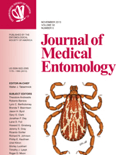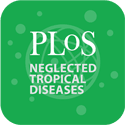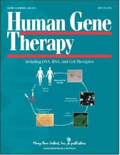
JOURNAL OF VECTOR ECOLOGY
metrics 2024
Connecting Science and Solutions for Vector Management
Introduction
JOURNAL OF VECTOR ECOLOGY, published by SOC VECTOR ECOLOGY, serves as a pivotal platform for the dissemination of research in the interdisciplinary fields of ecology, evolution, behavior, and systematics. Established in 1996 and operating from the United States, this esteemed journal boasts an impressive Q2 ranking in Ecology as of 2023, showcasing its significant contribution to the scientific understanding of vector ecology and its implications on public health and environmental management. The journal is indexed in Scopus, ranking #341 out of 721 in Agricultural and Biological Sciences focusing on Ecology, Evolution, Behavior and Systematics and #222 out of 461 in Environmental Science, highlighting its relevance and impact within these domains. Although it does not currently offer open access options, the JOURNAL OF VECTOR ECOLOGY remains committed to advancing knowledge and fostering collaboration among researchers, professionals, and students dedicated to vector analysis and control strategies.
Metrics 2024
 0.61
0.61 1.40
1.40 1.50
1.50 58
58Metrics History
Rank 2024
Scopus
IF (Web Of Science)
JCI (Web Of Science)
Quartile History
Similar Journals

JOURNAL OF MEDICAL ENTOMOLOGY
Bridging entomology and infectious disease research.JOURNAL OF MEDICAL ENTOMOLOGY, published by Oxford University Press, is a prestigious journal dedicated to advancing the field of medical entomology, a critical area of study that explores the intersection of insect biology and public health. With an ISSN of 0022-2585 and an E-ISSN of 1938-2928, the journal features high-quality research articles and reviews that delve into the impacts of insect vectors on infectious diseases and parasitology, making it an essential resource for professionals and researchers alike. The journal has garnered significant recognition in the academic community, currently ranking in the top quartiles: Q2 in Infectious Diseases, Q1 in Insect Science, Q2 in Parasitology, and Q1 in Veterinary (miscellaneous), reflecting its influential contributions to these disciplines. With its comprehensive coverage of topics spanning across medical entomology and veterinary sciences, authors and readers will find a platform rich in valuable insights and data. The journal's long-standing history, dating back to its inception in 1964, ensures a legacy of excellence that continues through 2024 and beyond. While it does not currently offer open access, researchers are highly encouraged to engage with its content to foster a deeper understanding of the crucial role that insects play in human and animal health.

MEDICAL AND VETERINARY ENTOMOLOGY
Exploring the Crucial Interplay of Insects and MedicineMEDICAL AND VETERINARY ENTOMOLOGY is a leading journal published by Wiley that focuses on the intricate relationships between insects and their roles in both medical and veterinary contexts. With an ISSN of 0269-283X and an E-ISSN of 1365-2915, this journal has established itself as an essential resource for researchers, professionals, and students alike, showcasing critical studies that advance our understanding of entomology's impact on public health and animal welfare. The journal spans from 1987 to 2024, indicating its long-standing contribution to the field, and it continues to maintain a strong reputation with an impressive categorization in the Q1 and Q2 quartiles across notable disciplines such as Insect Science and Veterinary Studies. While it is not an Open Access journal, its rigorous editorial standards and high impact factor make it a vital platform that attracts quality research in the ecology, evolution, and control of medically and veterinary important insects. As the field evolves, MEDICAL AND VETERINARY ENTOMOLOGY remains a pivotal asset for scholars striving to tackle current challenges and improve strategies in entomological research.

PLoS Neglected Tropical Diseases
Transforming research into solutions for tropical diseases.PLoS Neglected Tropical Diseases is a leading Open Access journal published by the Public Library of Science since 2007, dedicated to advancing research and awareness in the field of neglected tropical diseases. With an impressive 2023 impact factor reflected in its Q1 ranking in categories such as Infectious Diseases, Pharmacology, Toxicology and Pharmaceutics, as well as Public Health, Environmental and Occupational Health, this journal is recognized as a vital resource for researchers, healthcare professionals, and students alike. It is positioned prominently within the academic community, ranked in the top tier of journals according to Scopus, demonstrating its significant contribution to knowledge and innovation in global health. With its commitment to disseminating free and accessible scientific insights, PLoS Neglected Tropical Diseases plays a crucial role in addressing pressing health challenges and promoting a deeper understanding of diseases often overlooked in mainstream health discourse. For further information and to access its rich repository of articles, please visit the journal's website.

HUMAN GENE THERAPY
Exploring the Future of Genetic MedicineHuman Gene Therapy, an esteemed journal published by Mary Ann Liebert, Inc., is at the forefront of the rapidly evolving fields of genetics, molecular biology, and molecular medicine. With a significant impact in its domain, it is categorized in the Q2 quartile across multiple disciplines, reflecting its commitment to disseminating high-quality, impactful research. Established in 1990, the journal has continuously provided a vital platform for scientists and practitioners to explore groundbreaking developments in gene therapy, genetic engineering, and related technologies. With a focus on peer-reviewed articles that foster advancements in therapeutic applications, Human Gene Therapy serves not only as a comprehensive resource for academia but also as an essential reference for professionals engaged in genetic research and clinical practice. Although currently not open access, the journal remains a crucial source of knowledge, driving innovation and collaboration within the gene therapy community.

TRENDS IN PARASITOLOGY
Advancing the frontiers of parasitology research.TRENDS IN PARASITOLOGY is a premier academic journal published by CELL PRESS, focusing on the dynamic field of parasitology and infectious diseases. With an ISSN of 1471-4922, this esteemed journal is recognized for its high impact within the research community, boasting a Q1 ranking in both the Infectious Diseases and Parasitology categories as of 2023. This places it among the top-tier journals in the field, as evidenced by its remarkable Scopus rankings, where it ranks #3 out of 79 in Parasitology and #29 out of 344 in Infectious Diseases. Spanning over two decades of scholarly contributions from 2001 to 2024, TRENDS IN PARASITOLOGY emphasizes the latest advancements, challenges, and innovative methodologies in parasitology, making it an invaluable resource for researchers, healthcare professionals, and students alike. With an increasing focus on open access initiatives, this journal not only promotes widespread dissemination of knowledge but also encourages collaboration across the global scientific community. Whether you are investigating novel interventions, exploring parasite evolution, or understanding host-pathogen interactions, TRENDS IN PARASITOLOGY remains at the forefront of research, driving forward the understanding of parasitic diseases.

NAUTILUS
Navigating the Frontiers of Aquatic DiscoveryNAUTILUS is a distinguished journal published by the Bailey-Matthews Shell Museum, dedicated to advancing the understanding of aquatic sciences as well as ecology, evolution, behavior, and systematics. With an ISSN of 0028-1344, NAUTILUS has played a significant role in the scholarly community from its inception, with publication converged between 1996 to 2015 and 2017 to 2024. Although currently categorized as Q4 in Aquatic Science and Ecology, Evolution, Behavior and Systematics for 2023, the journal has a reputation for publishing high-quality research that contributes to the broader scientific discourse. Researchers and students alike can benefit from the insights provided by NAUTILUS, which remains committed to exploring the intricate relationships within aquatic ecosystems. Its editorial management, led by Dr. José H. Leal, ensures rigorous peer review and academic excellence, making it a crucial resource for those dedicated to discovering the complexities of aquatic and ecological research.

SOUTHWESTERN ENTOMOLOGIST
Exploring the Intersection of Insect Science and AgronomySOUTHWESTERN ENTOMOLOGIST is a pivotal academic journal dedicated to advancing the fields of Agronomy, Ecology, and Insect Science. Published by the SOUTHWESTERN ENTOMOLOGICAL SOC in the United States, this journal plays a crucial role in disseminating vital research findings that address pressing ecological and agricultural challenges. With its ISSN 0147-1724 and E-ISSN 2162-2647, the journal has been publishing comprehensive studies since 1993 and continues to contribute significantly to the knowledge base up to 2024. As a Q4 ranked journal in both Agronomy and Crop Science and Ecology, as well as Insect Science, it provides an inclusive platform for researchers and students to share their insights and foster collaborations. Although it currently does not offer open access options, the content is accessible to academic institutions and professionals, ensuring that significant findings reach a broad audience. Given its niche focus, SOUTHWESTERN ENTOMOLOGIST not only appeals to researchers and students but also to professionals looking to stay updated on the latest trends and developments in entomology and its related fields.

Journal of Vertebrate Biology
Fostering academic discourse on vertebrate evolution.Journal of Vertebrate Biology, a reputable publication established by the Institute of Vertebrate Biology in the Czech Republic, serves as a vital platform for research across the fields of Animal Science and Zoology, Aquatic Science, and Ecology, Evolution, Behavior and Systematics. With its ISSN 2694-7684 and a commendable 2023 Q2 ranking in multiple categories, this open-access journal embraces innovative scientific inquiry and fosters academic discourse. The journal's commitment to disseminating high-quality research is reflected in its Scopus rankings, positioning it within the top quartile in several impactful areas. As it continues to converge its focus until 2024, researchers, professionals, and students alike are encouraged to engage with cutting-edge studies that advance our understanding of vertebrate biology. This publication stands out not only in its scholarly contributions but also in enhancing global awareness of biodiversity and conservation issues.

Current Research in Parasitology & Vector-Borne Diseases
Exploring the frontiers of parasitology for global health.Current Research in Parasitology & Vector-Borne Diseases, published by ELSEVIER, is an influential journal dedicated to advancing the understanding of parasitology and vector-borne diseases. With an ISSN of 2667-114X, this journal is highly esteemed in the field, holding a prestigious Q1 quartile ranking in categories such as Animal Science and Zoology, Insect Science, and Parasitology, as well as a notable Q2 ranking in Virology for 2023. The journal's focus spans a crucial intersection of disciplines, offering a platform for innovative research that directly addresses global health challenges posed by parasites and vectors. Researchers benefit from its robust open-access model, which facilitates unrestricted dissemination of knowledge, making essential findings accessible to a wider audience. The journal continues to play a pivotal role in fostering scholarly dialogue and interdisciplinary collaboration within the scientific community, serving as a vital resource for professionals, students, and academicians interested in the dynamic and evolving field of parasitology.

ACTA ZOOLOGICA ACADEMIAE SCIENTIARUM HUNGARICAE
Exploring the Depths of Animal SciencesACTA ZOOLOGICA ACADEMIAE SCIENTIARUM HUNGARICAE, published by the Hungarian Natural History Museum, is a distinguished open access journal dedicated to advancing knowledge across the fields of Animal Science, Zoology, Ecology, Evolution, Behavior, and Systematics. Established in 2003 as an open access platform, this scholarly journal has actively contributed to the dissemination of critical research since 1996, positioning itself within the Q3 quartile in both its primary fields as of 2023. With its ISSN 1217-8837, ACTA ZOOLOGICA serves as a vital resource for researchers, professionals, and students aiming to explore and expand their understanding of animal biodiversity and ecology. Its publication features a variety of empirical studies, reviews, and critical commentaries that rigorously address contemporary issues in zoological sciences, underlining its commitment to fostering academic excellence and environmental sustainability. Researchers can access the journal’s extensive archives to deepen their inquiry into animal life, making it an essential addition to any academic library.